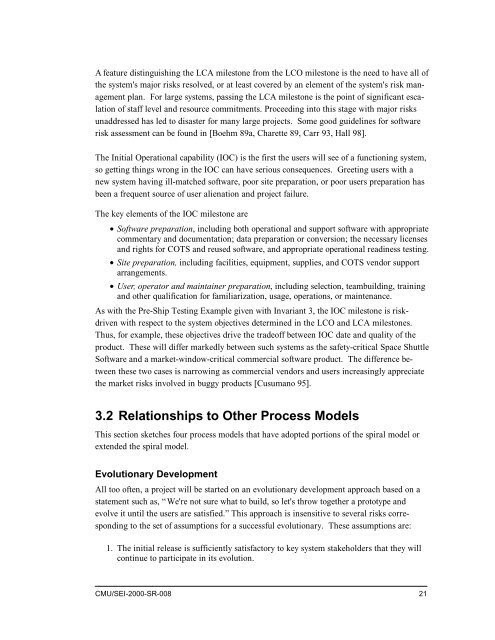00sr008
00sr008
00sr008
You also want an ePaper? Increase the reach of your titles
YUMPU automatically turns print PDFs into web optimized ePapers that Google loves.
A feature distinguishing the LCA milestone from the LCO milestone is the need to have all of<br />
the system's major risks resolved, or at least covered by an element of the system's risk management<br />
plan. For large systems, passing the LCA milestone is the point of significant escalation<br />
of staff level and resource commitments. Proceeding into this stage with major risks<br />
unaddressed has led to disaster for many large projects. Some good guidelines for software<br />
risk assessment can be found in [Boehm 89a, Charette 89, Carr 93, Hall 98].<br />
The Initial Operational capability (IOC) is the first the users will see of a functioning system,<br />
so getting things wrong in the IOC can have serious consequences. Greeting users with a<br />
new system having ill-matched software, poor site preparation, or poor users preparation has<br />
been a frequent source of user alienation and project failure.<br />
The key elements of the IOC milestone are<br />
•Software preparation, including both operational and support software with appropriate<br />
commentary and documentation; data preparation or conversion; the necessary licenses<br />
and rights for COTS and reused software, and appropriate operational readiness testing.<br />
•Site preparation, including facilities, equipment, supplies, and COTS vendor support<br />
arrangements.<br />
•User, operator and maintainer preparation, including selection, teambuilding, training<br />
and other qualification for familiarization, usage, operations, or maintenance.<br />
As with the Pre-Ship Testing Example given with Invariant 3, the IOC milestone is riskdriven<br />
with respect to the system objectives determined in the LCO and LCA milestones.<br />
Thus, for example, these objectives drive the tradeoff between IOC date and quality of the<br />
product. These will differ markedly between such systems as the safety-critical Space Shuttle<br />
Software and a market-window-critical commercial software product. The difference between<br />
these two cases is narrowing as commercial vendors and users increasingly appreciate<br />
the market risks involved in buggy products [Cusumano 95].<br />
3.2 Relationships to Other Process Models<br />
This section sketches four process models that have adopted portions of the spiral model or<br />
extended the spiral model.<br />
Evolutionary Development<br />
All too often, a project will be started on an evolutionary development approach based on a<br />
statement such as, “We're not sure what to build, so let's throw together a prototype and<br />
evolve it until the users are satisfied.” This approach is insensitive to several risks corresponding<br />
to the set of assumptions for a successful evolutionary. These assumptions are:<br />
1. The initial release is sufficiently satisfactory to key system stakeholders that they will<br />
continue to participate in its evolution.<br />
CMU/SEI-2000-SR-008 21














